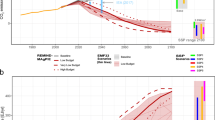Abstract
Bio-electricity is an important technology for Energy Modeling Forum (EMF-27) mitigation scenarios, especially with the possibility of negative carbon dioxide emissions when combined with carbon dioxide capture and storage (CCS). With a strong economic foundation, and broad coverage of economic activity, computable general equilibrium models have proven useful for analysis of alternative climate change policies. However, embedding energy technologies in a general equilibrium model is a challenge, especially for a negative emissions technology with joint products of electricity and carbon dioxide storage. We provide a careful implementation of bio-electricity with CCS in a general equilibrium context, and apply it to selected EMF-27 mitigation scenarios through 2100. Representing bio-electricity and its land requirements requires consideration of competing land uses, including crops, pasture, and forests. Land requirements for bio-electricity start at 200 kilohectares per terawatt-hour declining to approximately 70 kilohectares per terwatt-hour by year 2100 in scenarios with high bioenergy potential.






Similar content being viewed by others
Notes
Model output is interpolated to 10-year time steps, starting in 2010, for submission to the EMF-27 data base.
Policy scenario G19 is paired with reference scenario G01.
The SSP data are available for download at https://secure.iiasa.ac.at/web-apps/ene/SspDb
Income comparisons in the base year of 2004 are calculated using market exchange rates.
The idea of using a floor of $1 per tCO2 comes from Hyman et al. (2002) in the context of non-CO2 greenhouse gas abatement in a CGE model.
A fixed-coefficient constant-elasticity-of-transformation (CET) nest is used to represent joint products of electricity and CO2 permits in Fig. 4.
We use a CO2 capture rate of 95 % for fossil-generated electricity.
We do not use permit revenue to offset other tax rates in the economy.
The five field crops are wheat, rice, coarse grains, oil seeds, and sugar. The three crop types are vegetables and fruit, plant-based fibers, and other crops.
Labor productivity in each FARM region is adjusted to align GDP growth rates with the SSP2 scenario. Capital productivity changes are zero for all production sectors in all regions, with two exceptions: electricity from wind and electricity from solar.
Abbreviations
- AgMIP:
-
Agricultural Model Inter-comparison and Improvement Project
- CCS:
-
Carbon dioxide capture and storage
- CES:
-
Constant elasticity of substitution
- CGE:
-
Computable general equilibrium
- EMF:
-
Energy Modeling Forum
- EV:
-
Equivalent variation
- FARM:
-
Future Agricultural Resources Model
- FAO:
-
Food and Agriculture Organization of the United Nations
- GTAP:
-
Global Trade Analysis Project
- IEA:
-
International Energy Agency
- kha:
-
Kilohectare
- SAM:
-
Social accounting matrix
- SSP:
-
Shared Socio-economic Pathway
- TWh:
-
Terawatt-hour
References
Avetisyan M, Baldos U, Hertel T (2011) Development of the GTAP Version 7 Land Use Data Base. GTAP Research Memorandum No. 19, Global Trade Analysis Project, Purdue University, https://www.gtap.agecon.purdue.edu/
Burney JA, Davis SJ, Lobell DB (2010) Greenhouse gas mitigation by agricultural intensification. Proceedings of the National Academy of Sciences 107(26):12052–12057
Choi S, Sohngen B, Rose S, Hertel T, Golub A (2011) Total factor productivity change in agriculture and emissions from deforestation. American Journal of Agricultural Economics 93(2):349–355
Hertel TW (1997) Global trade analysis: Modeling and applications. Cambridge University Press, New York
Hertel TW, Rose SK, Tol RSJ (2009) Land use in computable general equilibrium models: An overview. In: Hertel TW, Rose SK, Tol RSJ (eds) Economic analysis of land use in global climate change policy. Routledge, London, pp 3–30
Hyman RC, Reilly JM, Babiker MH, De Masin A, Jacoby HD (2002) Modeling non-CO2 greenhouse gas abatement. MIT Joint Program on the Science and Policy of Global Change, Report No. 94
Kriegler E, O’Neill BC, Hallegatte S, Kram T, Lempert RJ, Moss RH, Wilbanks T (2012) The need for and use of socio-economic scenarios for climate change analysis: a new approach based on shared socio-economic pathways. Global Environmental Change 22:807–822
Rutherford TF (2010) GTAP7inGAMS. Available at http://svn.mpsge.org/GTAP7inGAMS/doc/
Sands RD, Schumacher K, Förster H (2013) U.S. CO2 mitigation in a global context: Welfare, trade and land use. Special issue of The Energy Journal, forthcoming
Schmer MR, Vogel KP, Mitchell RB, Perrin RK (2008) Net energy of cellulosic ethanol from switchgrass. Proceedings of the National Academy of Sciences 105(2):464–469
Schumacher K, Sands RD (2007) Where are the industrial technologies in energy-economy models? An innovative CGE approach to steel production in Germany. Energy Economics 29:799–825
United Nations, Department of Economic and Social Affairs, Population Division (2011) World Population Prospects: The 2010 Revision, CD-ROM Edition
Williams JH, DeBenedictis A, Ghanadan R, Mahone A, Moore J, Morrow III WR, Price S, Torn MS (2013) The technology path to deep greenhouse gas emissions cuts by 2050: The pivotal role of electricity. Lawrence Berkeley National Laboratory Paper LBNL-5529E
Wise M, Calvin K, Thomson A, Clarke L, Bond-Lamberty E, Sands R, Smith SJ, Janetos A, Edmonds JA (2009) Implications of limiting CO2 concentration for land use and energy. Science 324:1183–1186
Author information
Authors and Affiliations
Corresponding author
Additional information
This article is part of the Special Issue on “The EMF27 Study on Global Technology and Climate Policy Strategies” edited by John Weyant, Elmar Kriegler, Geoffrey Blanford, Volker Krey, Jae Edmonds, Keywan Riahi, Richard Richels, and Massimo Tavoni.
The views expressed are those of the authors and should not be attributed to the Economic Research Service, USDA, or the Öko-Institut.
Rights and permissions
About this article
Cite this article
Sands, R.D., Förster, H., Jones, C.A. et al. Bio-electricity and land use in the Future Agricultural Resources Model (FARM). Climatic Change 123, 719–730 (2014). https://doi.org/10.1007/s10584-013-0943-9
Received:
Accepted:
Published:
Issue Date:
DOI: https://doi.org/10.1007/s10584-013-0943-9




